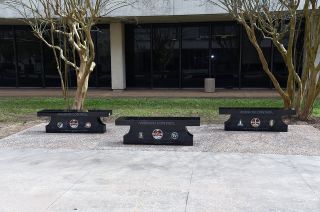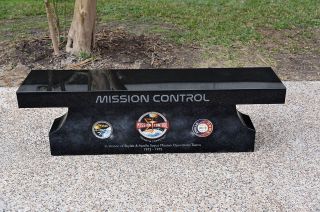NASA dedicates new benches of honor to veterans of Mission Control
The monuments pay tribute to the controllers of the past, from Gemini to the space shuttle era.

A trio of new monuments at NASA's home for human spaceflight pays tribute to the flight control teams of the past by inviting visitors to sit down and reflect on what was made possible from inside the Mission Control Center in Houston.
In the five decades between when the Johnson Space Center (formerly Manned Spacecraft Center) began supporting human missions and when the space shuttle was retired, nearly 400 astronauts and cosmonauts launched into space knowing that they had support from the men and women staffing the control rooms.
Tallying up all of the flight controllers, flight directors, scientists, engineers and others who worked in the Christopher C. Kraft, Jr. Mission Control Center (MCC), as it is known today, more than 6,000 people worked to ensure that the missions were a success and that the crews returned safely to Earth.
In recognition of their 46 years of service, NASA officials and members of the Manned Spaceflight Operations Association (MSOA) on Thursday (April 28) dedicated three black granite benches — one for each for the teams behind the Gemini and Apollo programs; the Skylab flights and Apollo-Soyuz Test Project; and the space shuttle missions. The MSOA privately funded the benches with donations from 98 of the non-profit organization's members.
Lunar legacy: 45 Apollo moon mission photos

"We're thankful to the Manned Spaceflight Operations Association for dedicating these benches in honor of our NASA flight control teams who captured the world's attention and demonstrated the power of America's vision and technology through many historic missions spanning Gemini to shuttle," Vanessa Wyche, director of the Johnson Space Center, said in a statement.
"These benches will serve as a constant reminder of this lasting legacy, as we work to inspire the next generation of explorers with our Artemis moon to Mars program," Wyche added.
Get the Space.com Newsletter
Breaking space news, the latest updates on rocket launches, skywatching events and more!
Related: NASA's Artemis program
Restoring the people to the room
The idea for the benches came out of the work that was done in 2019 to restore one of the Mission Control Center's flight control rooms to how it looked at the time of the Apollo moon landings. Now the room appears as if the flight controllers had just gotten up from their consoles, leaving behind their active displays, documents, coffee cups and cigarette butts in their ash trays.
"The whole story of [the benches] is to bring the people part of it back into it after the Johnson Space Center did such a great job of restoring the control room," said Gerry Griffin, who served as a flight director during the Apollo program and was present for Thursday's ceremony.
The benches of honor are positioned along a walkway used by current MCC team members but which is also accessible by retirees and the general public who come to see the restored Apollo control room by way of the tram tours operated by Space Center Houston.

Each bench has a similar appearance at the suggestion of Gene Kranz, the flight director who led Mission Control for the first moon landing and the recovery of the Apollo 13 astronauts.
"Kranz wanted the mission operations patch at the center of each of the benches," Bill Reeves, a former flight director whose career in the MCC extended from the beginning of Apollo to the end of the space shuttle program, said in an interview with collectSPACE.com. "So we did that, and then we put the program patches on either side and the words 'Tough and Confident,' which was the mantra of the operations teams that Kranz had come up with and we always held."
The words "Mission Control" and the dates of the individual programs complete the engravings on each bench.
"Griffin and Kranz are old fighter pilots, so they wanted to put the benches in a flight formation," said Reeves. "The Gemini and Apollo bench is in the lead, with the Skylab and Apollo-Soyuz bench off the right wing and slightly behind and the shuttle program bench is off the left wing and further behind. So chronologically, that's the way they're set up."
Seats with a view
The teams overseeing the International Space Station today are not represented on a bench because it is still an operational program.
"We didn't include the station program because it's still active," said Reeves. "So whenever that program is over, if somebody wants to add another bench for the space station program, they can do that."
Though the primary purpose of the benches is to honor those who came before, they are also intended to engage the public into thinking about what comes next.
"It can't be just a look back," Griffin told collectSPACE. "I think it's got to be to look back and ultimately make people look to the future."
"I would like those who come to sit here to think about how we got people to the moon, we did it and it can be done, but what's the plan to get back?" said Griffin. "And then they'll want to know more about Artemis."

Reeves also hopes those who come to sit on the benches can span generations of flight team members.
"I am sure tourists will want to sit down and get their picture taken sitting on them, especially if it is anybody who had a grandfather or grandmother that worked in the program," said Reeves. "It is a chance for them to see that there's a memorial for those folks."
Follow collectSPACE.com on Facebook and on Twitter at @collectSPACE. Copyright 2022 collectSPACE.com. All rights reserved.
Join our Space Forums to keep talking space on the latest missions, night sky and more! And if you have a news tip, correction or comment, let us know at: community@space.com.

Robert Pearlman is a space historian, journalist and the founder and editor of collectSPACE.com, an online publication and community devoted to space history with a particular focus on how and where space exploration intersects with pop culture. Pearlman is also a contributing writer for Space.com and co-author of "Space Stations: The Art, Science, and Reality of Working in Space” published by Smithsonian Books in 2018. He previously developed online content for the National Space Society and Apollo 11 moonwalker Buzz Aldrin, helped establish the space tourism company Space Adventures and currently serves on the History Committee of the American Astronautical Society, the advisory committee for The Mars Generation and leadership board of For All Moonkind. In 2009, he was inducted into the U.S. Space Camp Hall of Fame in Huntsville, Alabama. In 2021, he was honored by the American Astronautical Society with the Ordway Award for Sustained Excellence in Spaceflight History.

